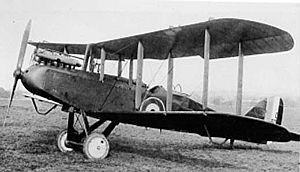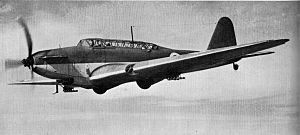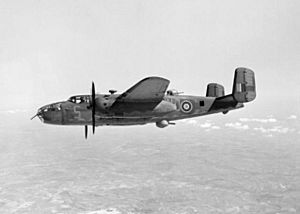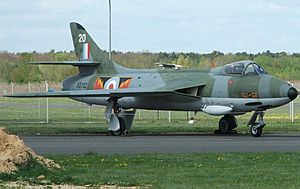No. 98 Squadron RAF facts for kids
Quick facts for kids No. 98 Squadron RAF |
|
|---|---|
| Active | August 1917 – March 1919 February 1936 – July 1941 September 1942 – July 1957 August 1959 – February 1976 |
| Country | |
| Branch | |
| Motto(s) | Never failing |
| Battle honours | Western Front 1918 Amiens Lys Atlantic 1940–1941 Fortress Europe 1940–44 Normandy 1944 France & Germany 1944–45 Rhine |
| Insignia | |
| Squadron Badge heraldry | Cerberus. The squadron claims to have barred the way (front and rear) during the German retreat in 1918 and so considered Cerberus, as the watchdog of Hades, a suitable badge. |
| Squadron Codes | VO, OE |
| Aircraft flown | |
| Bomber | Airco DH.9 Hawker Hind Fairey Battle B-25 Mitchell de Havilland Mosquito de Havilland Vampire de Havilland Venom |
| Electronic warfare |
English Electric Canberra |
| Fighter | Hawker Hunter |
No. 98 Squadron was a special group of pilots and planes in the Royal Air Force (RAF). They flew different types of aircraft, like bombers and fighter-bombers, during World War I and World War II. After these big wars, they even worked with missiles and helped calibrate radars. The squadron was active for many years before it was finally disbanded in 1976.
Contents
History of No. 98 Squadron
No. 98 Squadron had a long and interesting history. It was formed, disbanded, and reformed several times, always adapting to new challenges and aircraft.
World War I Missions
No. 98 Squadron was first created on August 30, 1917. Back then, it was part of the Royal Flying Corps (RFC). They trained in England before moving to France in April 1918.
Their main job was "day-bombing," which meant dropping bombs during the day. They flew planes called Airco DH.9s. The squadron quickly joined major battles like the Battle of the Lys and the Battle of Amiens.
Towards the end of World War I, they also did a lot of reconnaissance. This means they flew missions to gather information about enemy positions. After the war ended in November 1918, the squadron returned to England and was disbanded in March 1919.
During their time in France, the squadron was very active. They claimed to have destroyed or damaged many enemy aircraft. However, they also lost many of their own planes and brave airmen.
Reforming the Squadron
No. 98 Squadron was brought back to life on February 17, 1936. This time, they were based at RAF Abingdon in England. They started with Hawker Hind bomber planes.
Later, in 1938, they upgraded to a new type of aircraft called the Fairey Battle. These planes would soon be used in the next big conflict.
World War II Operations
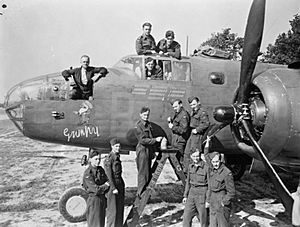
When World War II began, No. 98 Squadron was a reserve unit. In 1940, they moved to France, but they didn't fly any combat missions there. They had to evacuate back to England during the Battle of France.
Sadly, during this evacuation, many of their personnel were lost. Their ship, the RMS Lancastria, was bombed and sunk. After this tragedy, the squadron regrouped in England.
They then joined Coastal Command and moved to Iceland. Their job there was to patrol the coast and hunt for enemy submarines. They even had a few Hawker Hurricane fighter planes to help. The squadron was disbanded again in July 1941.
- A Discovery in Iceland*
Years later, in 1999, something amazing happened. Melting ice on a glacier in Iceland revealed the wreckage of one of their planes, a Battle P2330. This plane had disappeared in 1941. The remains of the four airmen on board were found and given a proper burial.
No. 98 Squadron was reformed for the third time in September 1942. They became a bomber squadron again, flying the powerful North American Mitchell II aircraft.
They started by flying Air Sea Rescue (ASR) missions. Their first attack on the enemy was in January 1943, targeting oil buildings in Belgium. This mission was tough, and they faced strong enemy fire.
After some plane improvements, they returned to combat in May 1943. They attacked railway yards in France. In August 1943, they moved to Dunsfold to prepare for the Normandy landings. They also attacked V1 flying bomb sites.
After the Normandy landings, the squadron supported the Allied armies as they advanced. They moved to bases in Belgium and then Germany, staying active until VE Day.
Cold War Era
After World War II, the squadron stayed in Germany. They changed planes several times. In 1945, they flew the de Havilland Mosquito. In 1951, they got de Havilland Vampire fighter-bombers, and then Venoms in 1953.
In 1955, they received the Hawker Hunter and became a day fighter unit. They continued in this role until they were disbanded again in July 1957.
- Missile Squadron*
No. 98 Squadron was reformed once more in August 1959. This time, they became a Strategic Missile (SM) squadron. They were equipped with three Thor Intermediate range ballistic missiles. These powerful missiles were based at RAF Driffield.
During the Cuban Missile Crisis in October 1962, the squadron was on high alert. Their missiles were aimed at important targets in the USSR. This was a very tense time in history. The Thor Program ended in Britain, and the squadron was disbanded in April 1963.
- Radar Calibration*
The very next day, a different unit, No. 245 Squadron, was renumbered as No. 98 Squadron. This new No. 98 Squadron's job was radar calibration. They used English Electric Canberra planes for this work.
They moved bases a few times before finally settling at RAF Cottesmore. No. 98 Squadron was officially disbanded for the last time on February 27, 1976.


